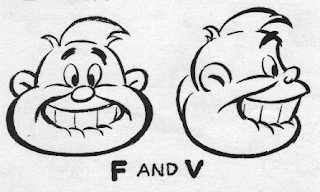 |
| The Ugly; here, Preston Blair's sophisticated design and animation suddenly devolved back to the primitive level of 1930 or 1931. |
Notwithstanding my entirely positive review of Preston Blair's Animation in post number 105, I now want to focus on a single page in the book that has probably had a deleterious effect on many independent animators through the years. I am referring to the page on dialogue.
Unaccountably, the author included this whole sheet of outdated examples of grotesque mouth positions that bring to mind the crude and hammy voice acting of early sound cartoons of about 1930. In those days it was understandable, since "talkies" were a novelty in live-action as well as animation, and no one had any experience in it. Dialog was still often post-recorded and techniques of analyzing pre-recorded dialog tracks frame-by-frame had yet to be developed. This kind of exaggeration was used even at Disney then, at a time just before that studio began to pull ahead of all the others in every aspect of production values.
To me it brings to mind the Bosko cartoons of Harmon-Ising, especially of Bosko's signature sign-off (later to be taken over by Porky Pig), "That's all, folks!"
 |
| Bosko says "That's all, folks!" |
But by the late 1940s when this book came out, the world had seen in animation the advent of color, of believable personality animation, and such milestones as Snow White, Pinocchio, and the fully developed character Bugs Bunny.
 |
| The Bad: Preston Blair's Dialogue page, a throwback to another time. |
Perhaps he had some idea of first showing this over-done version to make students aware of the significance of mouth shapes in dialog, before then encouraging the more subtle approach of animating phrases with only an occasional stressed shape.
Indeed, one little paragraph in the lower left corner of the page does redeem him somewhat, stating that "It's better to follow this over-all mouth pattern, and hold down or modify individual syllables not important to the whole."
 |
| The Good: A short paragraph encouraging a different approach. |
Next: One more post about the books of Preston Blair.

No comments:
Post a Comment